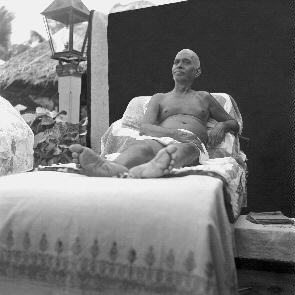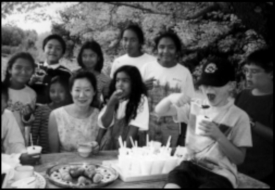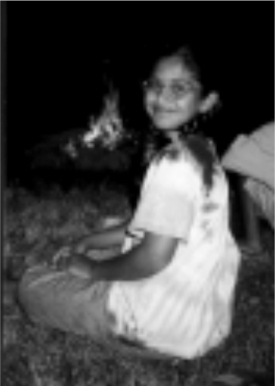Enquiry and Sadhana
(part 1}
The following is an excerpt from questions and answers exchanged between Bhagavan Sri Ramana Maharshi and Sri D.C.Desai, I.R.S.E., Executive Engineer, E.I. Railway, at Sri Ramanasramam, Tiruvannamalai, South India, on 24-8-1944 at 9 a.m. and recorded in the October 1969 issue of 'The Mountain Path'.
Sri Desai: During the enquiry, should I repeat mentally the question "Who am I (Koham)?" etc., just like the Japa of a mantra again and again, with feeling and understanding of the same...?
Sri Maharshi: Japa of Koham is not correct. Put the question once only and then concentrate on finding the source of the ego, and preventing recurrence of thoughts.
D: Should I endeavour to breathe in and out deeply and rhythmically during the enquiry, and synchronize the formula, Koham, with the same? Or should I pay attention to the incoming and outgoing breaths, while repeating the questions, Koham, Kutoham, etc.?

M: You should not attend to the breathing if you are capable of concentrating on the enquiry without it. Some may have to attend to the breathing if unable to concentrate on the enquiry alone. Some may practice kevala kumbhaka [retention of breath] during the enquiry. Some may require the help of regular pranayama also to steady the mind and control the thoughts.
All these practices are to be given up when the mind becomes strong enough to pursue the enquiry without their aid. Pranayama is to be practiced with the usual caution. It will gradually increase the power and duration of the kumbahaka. It will make the mind one-pointed. Take its help if unable to concentrate without it. Pranayama is like reins to control the mind-horse, or like brakes to control the wheel of thoughts. "Who am I?" and "Whence am I?" are one and the same. They refer to the ego only. No such questions can be asked in the case of the Real Self.
D: I have been practicing other forms of sadhana apart from saguna meditation, such as japa, mantra-writing, kirtan, bhajana, swadhyaya, spiritual propaganda, lectures, free distribution of religious publications, etc. Should I continue these in addition to the enquiry of "Who am I?" if I get spare time, or should I curtail some or all of these and spend more time in the enquiry only? Will the above practices be helpful in quickening my progress in the enquiry?
M: Without losing hold of the knowledge of who you are, you may continue to perform all activities as prompted by the inner controller. They will go on even without your efforts. What you are destined to do, you cannot avoid. They will come your way of their own accord. You should also understand what japa, kirtana, etc. are meant for. Become and stay what you are. The real japa is always going on. Japa and God are one and the same. See the "Philosophy of the Name" as given by Saint Namdev.
D: In the enquiry "Who am I?", does the I refer to the ego or the Atman?
M: In the enquiry, 'I' refers to the ego.
D: Are my present qualities of faith, humility and surrender sufficiently intense, or are they still very imperfect and require further development? If so, how can I quickly develop them to perfection so as to deserve Grace and early success in the realization of Atman, or in the annihilation of the ego?
M: Do not entertain such thoughts of imperfection, lack of qualities, etc. You are already perfect. Get rid of the ideas of imperfection and need for development. There is nothing to realize or annihilate. You are the Self. The ego does not exist. Pursue the enquiry and see if there is anything to be realized or annihilated. See if there is any mind to be controlled. Even the effort is being made by the mind which does not exist.
Swami Siddheswarananda
Swami Siddheswarananda was the monk of the Ramakrishna Order who founded the Ramakrishna Ashrama in Gretz, France in 1947. He passed away in 1961. From his youth he had much love and reverence for Sri Maharshi, as testified by the numerous articles he wrote about him.
The following notes were gathered by Richard Selvame of Paris, France. On his many visits to the Ramakrishna Ashrama near Paris he made the friendship of an old disciple of Swami Siddheswarananda who kindly gave him access to her diary wherein she recorded several interesting incidents told to her by the Swami.
Sri Swami Brahmananda was one of Sri Ramakrishna's greatest, direct disciples and first President of the Ramakrishna Order. He was also known as Rakhal. He was Swami Siddheswarananda's Master. When Swami Siddeshwarananda was a student in Madras, someone told him about Sri Ramana Maharshi. He at once became very thrilled and thought that there must be something great about this Sage and began to visit him in Tiruvannamalai. When he joined the Ramakrishna Order and became a disciple of Swami Brahmananda he related to his Guru enthusiastically about the life and teachings of Sri Bhagavan. Swami Brahmananda Maharaj, understanding the love of his disciple for Sri Ramana, used to say: "Please tell me more about this Sage."
Sri Krishna
A so-called "enlightened man," who took himself for Sri Krishna, came for the darshan of Ramana Maharshi, wearing clothes like Krishna. The Maharshi appeared to take him very seriously and treated this enlightened one as Krishna himself. He even arranged for one of his attendants to give special treatment to him, like one making puja to an idol of Krishna with all the worship items, etc. The "enlightened one" was very pleased and went out. All the disciples who were there protested against the Maharshi's treatment of this pseudo-Krishna, saying that was not proper for him to treat that man in this manner, etc. Sri Ramana silenced them all by saying: "All of you here are taking yourself for mister X or mister Y, so what's wrong for this one taking himself for Sri Krishna."
American Lady
Swami Siddeshwarananda was once again at Sri Ramanasramam just after the Second World War when the following event took place on the very day he arrived there from Paris:
An American lady arrived for the darshan of Ramana Maharshi and expected the Maharshi to speak to her. Unfortunately, he never addressed a single word to her. She tried her best to talk to him, but was very disappointed by the silence of the master. She also asked the Master's attendant how many dollars it would cost for the Maharshi to agree to speak to her. The attendant just laughed and went his way.
Being hurt and disappointed she decided to leave the Ashrama. While departing with her luggage on a narrow footpath, wonder of wonder, Sri Ramana Maharshi was approaching by the same footpath from the opposite direction. When they were very close, face to face - she was so determined not to speak first - the master stopped, looked at her and asked, "Are you going?" The lady was so completely touched by these few words that she dropped her luggage and said, "No, I am staying." She remained and lived many years at the Ashrama, even after the Mahasamadhi of Sri Maharshi.
Swami Ritajananda
After the death of Swami Siddeshwarananda, Swami Ritajananda became the second Swami in charge of the Ramakrishna Ashram near Paris till 1994. Sri Sivananda (Mahapurusha), another of Sri Ramakrishna's first disciples, was his Master. I personally met him in 1987. He was very fond of me [Richard Selvame]. Sometimes we would go for walks and discuss in Tamiḷ about India and many other things. Once he shared with me his joy of having darshan of Sri Ramana. When Ramana saw Swami Ritajananda he began to laugh, but did not talk to him. The Swami also told me that when he was in Madras on April 14, 1950, he saw the shooting star at the time the holy body of the Maharshi died in Tiruvannamalai.
Sri Ramana's Children's Ashrama 2001
The following was submitted by Saraswati Singh, one of the children of this year's Children's Ashrama program in Nova Scotia.
In August this year, Arunachala Ashram in Nova Scotia held a five day long Children's Ashrama. There were twelve kids from 4 to 17 who came everywhere from Maryland to Michigan and Canada.
A few days before the Children's Ashrama began we received a surprise in the mail from South Korea. It was box of twenty T-shirts for children. They all had a small, colorful drawing of a Buddhist monk running in the rain holding an umbrella. We all wore these shirts on the first day of the program and the words written just under the little monk seemed to tell the story of what we were about to experience during the next five days - "Joyful Ashrama!" We later discovered that Sona Gwon, our friend from Korea, sent us this surprise.
Once the Children's Ashrama started we were busy from dawn to dusk. The day would begin at eight in the morning when there was a mad rush to the washrooms. (After the first day some of the smarter ones woke up earlier.) We then had a fifteen minute meditation class which was split into a younger and older group. The older class learned about Self-enquiry, breath regulation, japa, and Guru seva, while the younger class chanted and learned about meditation. Ironically enough, it was the older kids who were always late for the pradakshina around the temple. Once the younger kids went around seven times singing "Arunachala Siva" before we older kids came out!
By now everyone was running five to ten minutes late. All of us ambled up the stairs for Upadesa Saram class with Dr. Ajay Kumar, who has a British accent. We learned how to say all the words. He would pick out a verse here and there to explain and tell stories about. Alexi, a 6-year-old Ashrama camper, sat in front to show everyone how to sit straight, since he couldn't read the words. In the next class we learned about Bhagavan and animals, as well as Arunachala and Bhagavan. We did art work after our lessons. It consisted of decorating a large picture of Arunachala and making sculptures of the animals associated with Bhagavan. While we were busy there would be a snack made for us which always had something that consisted of chocolate. (Yumm!)
We would slowly trickle out with food stuffed in our mouths to go to the Sacred Music and Songs Class. The teacher, Evelyn Saphier, and I played guitar while we practiced our songs. Later in the week John Cierpilowski taught us four dances with songs which were performed for and with the adults. By now it was 11:30 A.M. (or a little later) and it was Guru seva or service time. We would clean, dust, set the table, help in the barn, anything that we could do. When everything was ready, there was a nice loud and chaotic lunch. We kids got to get our food first so most of us picked nice portions of pasta and a little bit of Indian food.
On each of the five days we did something different from 1:00 to 4:00 P.M. On the first day, Sunday, we had free time so we could get to know each other and draw pictures for our smash hit play, "The Story of Arunachala." On Monday we went on a hike up the mountain with Arthur Coucouvitis to the cave. Seventeen of us fit into the cave where we sang and chanted by candlelight. Now on Tuesday we went to the Mandala Horse Riding Centre. We fed the Icelandic horses hay and learned how to brush the horses and which brushes to use. Most importantly we were taught what to do so the horses wouldn't kick us. Then we got onto the horses and rode in a ring. While our parents were taking their many pictures, we tried tricks like leaning back on the horse. To put it simply, it was FUN. On Wednesday we spent most of the day at Kejimkujik Park, which means "Swollen Water" in a Native Canadian language. The best part came soon after we arrived when we went canoeing with oars, wearing our life jackets. Most of us learned how to steer the canoe in a straight line. I repeat, most of us. We ate on picnic tables and then went to the playground which was between the tables and the lake. Near the lake we saw a nonpoisonous garter snake slithering into its hole near the water. Then we went to the swimming area on the lake. Adults and kids alike swam and had just some plain old fun in the water for a few hours.
We started to get out when Nikitha and Jon, two fellow Ashrama campers, saw two catfish with long whiskers. Then we saw a dead minnow floating. The life guard came and told us what it was. After we made him show the dead fish to every camper, he disposed of it. We changed out of our swimming suits and trunks and then had ice cream. It was really good, even the bees who chased after us liked it. Then on the last day of camp we rented the whole swimming pool in Lawrencetown and had a splashin' good time.
In the afternoons everyday we went, if we wanted, to listen to the Veda Parayana in the Temple. Then we all went to dinner and then to puja again. At puja we showed off all our newly-learned songs. Finally on the last, very last day, we had pizza and a big bonfire. All thirteen of us were given awards. Camper number thirteen was Oslo, the dog. He got a certificate for the most devoted retriever.
Letters and Comments
Glimpses of Reality
Awareness of the Presence
Dear Editor,
Thank you for sending me the last issue of the newsletter with my book order. I noticed that questions and comments were answered and I was wondering if you could help me understand an experience I had some months ago.
One morning I woke up with the strange feeling that part of me had not slept at all but had been a witness to my dreaming. I have to say "part of me" because the awareness had been inside of me so it had to be me, but there was something very different from myself in that presence. I could remember my dream adventures and my own self participating, and at the same time, could feel that I had been "observed from within" by that presence. At the time I was only acquainted with theories about the unconscious and I explained it to myself as an encounter with my "unconscious". This happened before I had been aware of Ramana Maharshi's teachings or practiced regular meditations.
One morning, some weeks later, I had another experience. I became aware of that presence on waking up, just at the point between sleeping and dreaming, as if I had "caught it unaware". It was very intense. It is difficult to find words to describe it. It felt as being inside and outside of me at the same time, aloof, unemotional, eternal, unconcerned. It left me with a feeling of awe and I called the presence for myself (I have never talked about it before today) "the silent watchman" or "the eternal watchman".
At about the same period I read about the Self and thought there were many similarities. I have since wondered if it is possible to have just a glimpse of the Self (apart from Self-Realization) and if this is what has happened (I feel that these experiences were more than sleep or dream illusions). I also wonder if the memory of that impressing presence can be of spiritual help to me.
The experiences you had in sleep and during the transition from sleep to waking are authentic spiritual experiences. It is no coincidence that these experiences occurred during a period of your life when you were actively seeking Truth and reading teachings, such as those of Sri Ramana Maharshi. These 'glimpses' are the incentives, or the grace, given to us. They are the road signs leading us to the final destination, and also the destination itself.
The Maharshi explained that when a person wakes up from sleep the head is raised and there is the light of awareness. The light is already there in the heart which is later reflected on the brain and appears as consciousness. Then the individual ego steps in and projects thoughts, identifying itself with the mind, body and world. There is a state in the interval between sleeping and waking, or between two thoughts, which is the undifferentiated Self, the Eternal Being. That state usually passes off unnoticed. You were fortunate to have been aware of it and understood that it is the "Eternal Watchman," the Self. That "Eternal Watchman" is your real nature, not the ego and multiplicity of thoughts which followed that experience. Hold on to that 'Watchman' in all the three states of waking, dreaming and sleeping. That is the ultimate purpose of taking a human birth. Still the mind and rest in this 'Watchman'. Then the game is over and you rest in eternal peace and joy.







The Formless Being
Dear Editor,
I live in Greece. I came across Bhagavan's teachings in NYC at the 6th Street Ashram in the mid 1980s when I was a student in the U.S.A. I have met the Indian person - I believe his name is Bhagawat - who was in charge then of the Ashram in NY. I once chanted with him Arunachala Siva mantras and I bought most of the books which were available then at the Ashram. I must have visited there a couple of times, though I do not remember exactly how many times.
Since my youth I have been a seeker of truth and have read about and practiced most of the important methods and read books on the Vedanta. I have had various spiritual experiences in my life and I must say that I am very grateful for the presence of the Lord Ramana.
I do not usually write or speak about my experiences nor do I read any more books during the past ten years. I only meditate in the manner taught by Sri Ramana.
I would like to ask you if you would kindly comment on an experience of the Formless Reality I once had, wherein neither I or the world or my body was perceived - not even the memory of this world. The only thing perceived was the Being and all was the Being, and that there was no time that this Being was not, and that there is nothing which is not that Being in an immense Bliss; and I was 'That' and there was no I there to claim it, and that everything was 'That' and that there is no time when I was not It.
I had this experience once in my life after intense Self-enquiry and in between the sleep and waking state.
My question is: Are there others who experience this on a daily basis? Do you know of anyone who goes into this state effortlessly?
The question is whether regular experience of this state is possible? Has it been done before?
I wanted to go to India but every time I think about going I was not sure if in the India Ashram there are people who are realized. I have visited many places in the world where there should have been living a presence of the Self, but have found it very disappointing. Is this the case also with Sri Ramanasramam?
If you have any answers that you could share with me I will be happy to hear from you.
Salutations to the Lord of your Heart,
Thank you for your kind and revealing letter. Of course, the experience you narrate is the experience of the Self that the Maharshi spoke about. But the plenary experience is what he called Sahaja Samadhi, where one does not go into or out of it, but it remains as an unbroken stream of pure awareness throughout the waking, dream and sleep states.
We have met disciples of Sri Bhagavan who received the grace to enter into this state often and some who even lived that state alone. The latter type is very rare. Most sincere sadhakas who strive throughout their lives for perfection and have experiences of it, such as you did, or perhaps experience it frequently, can in their last earthly moments enter into that experience and attain liberation at the time of death. This is called videhamukti. Jivanmuktas are the living-liberated. Bhagavan was a Jivanmukta. This is very rare.
There may be some exceptional souls who are Jivanmuktas living in India and other lands. If it is our destiny to meet them, we will. Only a true Jivanmukta can recognize another Jivanmukta.
"Is the regular experience of this state possible?" Yes, it is possible. It is our final destination. The saints and sages of all times have only been speaking of this.
If you visit the India Ashram you will not be disappointed. The Maharshi's presence and the powerful presence of the holy Arunachala Hill can be experienced in Tiruvannamalai. Your experience of the Self will be intensified and stabilized more easily there. Sri Bhagavan's physical absence has not diminished his influence. Please go and see for yourself.
This Formless Reality is our true Self. The body, mind and world are simply thoughts. To abide in the Formless Reality and know we are 'That,' is the purpose of life. Please forget all else and abide in 'That' alone. Only then will you have done what needs to be done and will be a beacon light unto the world.
New Publications
Arunachala-Ramana, Multimedia CD (out of print as of Jan 2020)
Designed to provide devotees of Bhagavan Sri Ramana Maharshi with a unique source of information and high-quality photographs. This CD has taken 18 months to construct and has gone far beyond its original parameters. No effort has been spared in its production. The CD contains over 1,400 specially prepared photographs and 1,350 pages. There are also audio files and video previews.

The files on the CD are in Adobe Acrobat PDF format for cross-platform compatibility, the retention of high-quality images and font styles, including Tamiḷ and Sanskrit.
CD Contents
75 full-page high-resolution restored photographs of Bhagavan, including the only known colour photograph, plus digitally coloured images
The Ashrama archival catalogue of 520 high-resolution photographs
71 pages of high-resolution stunning photographs of Arunachala taken by various photographers, 62 of them full-page size
The Giri Pradakshina map and photographs of the shrines at the eight directions. A map of Sri
Arunachaleswara Temple and many photographs of the Temple itself.
A greatly expanded 'Tour of Sri Ramanasramam' with high-quality photographs
The Ashram staff photographs complete with their names ... updated April 2001
Samples of Bhagavan's handwriting as high-resolution images
The entire contents of the 'Nirvana Room' have been photographed and added as detailed images - devotees rarely get the chance to see these items used by Bhagavan
A list of books, prints and videos available for purchase, complete with numerous book extracts and video previews
4 complete books to print out on 62 pages
Information on visiting Sri Ramanasramam, plus help for devotees
The first four 1964 editions of The Mountain Path Journal in original format
The complete set of The Maharshi Newsletters, produced by Arunachala Ashrama on 469 pages
Details and photographs on four of the local Tiruvannamalai charities
MP3 sound files - the Introductory Verses and Arunachala Aksharamanamalai
Bhagavan's medicinal skill - complete herbal recipes included
please visit the Multimedia web page for more details & downloads. (out of print as of Jan 2020)




